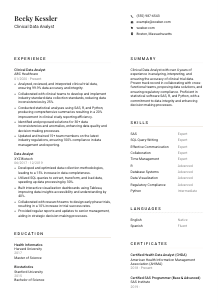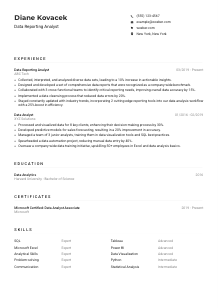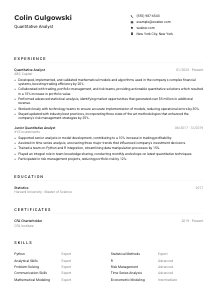Clinical Data Analyst Resume Example
Unraveling medical mysteries with data, but your resume feels like a puzzling diagnosis? Check out this Clinical Data Analyst resume example, concocted with Wozber free resume builder. Discover how to integrate your analytical acumen with job demands, making your career prognosis as accurate as a clinical trial outcome!

How to write a Clinical Data Analyst resume?
As a Clinical Data Analyst, you're on the frontline of transforming clinical trial data into actionable insights. The bridge between raw data and impactful healthcare advancements is built by your skills. But before you can make your mark, you need to navigate the first challenge: getting noticed with a powerful resume.
That's where this guide, powered by Wozber's free resume builder and dedicated tools for ATS optimization, comes into play. From honing your personal details to aligning your experience and skills with the role's needs, we'll delve into creating a Clinical Data Analyst resume that's not just a collection of experiences but a testament to your potential.
Personal Details
Your journey to landing the Clinical Data Analyst position starts with the personal details section. This is your first handshake with the potential employer, so let's ensure it's firm, confident, and perfectly tailored.
1. Brand Yourself Boldly
Start with your name, but remember, it's more than just a label - it's the headline of your professional narrative. Ensure it's in a clear, bold font to make an immediate impact.
2. Match the Role Title
Beneath your name, echo the role you're aspiring for - "Clinical Data Analyst". This alignment helps streamline your resume through the ATS, making it clear you're targeting this specific position.
3. Essential Contact Details
Include your phone number and a professional email address. Think of these as your open lines of communication - clear, direct, and error-free. Your email format, preferably firstname.lastname@email.com, sets a professional tone from the get-go.
4. Location Precision
Mentioning "Boston, Massachusetts" confirms your alignment with the job's geographical requirements, instantly resolving any potential concerns about your availability or the need for relocation.
5. Professional Online Presence
If applicable, adding a LinkedIn profile or personal website dedicated to your professional achievements or portfolio can bolster your first impression. Ensure these profiles are current and echo the professionalism of your resume.
Takeaway
In the vast ocean of resumes, your personal details are the lighthouse guiding hiring managers to your shore. Crafted with precision and aligned with the Clinical Data Analyst role, they signal your readiness and geographical fit. Now, let's ensure the rest of your resume shines just as brightly.





Experience
The Experience section is where you turn data into stories - stories of success, innovation, and skill. Here, you'll align your professional narrative with the expectations for a Clinical Data Analyst, demonstrating your readiness to thrive in this role.
- Analyzed, reviewed, and interpreted clinical trial data, ensuring 99.9% data accuracy and integrity.
- Collaborated with clinical teams to develop and implement industry‑standard data collection standards, reducing data inconsistencies by 25%.
- Conducted statistical analyses using SAS, R, and Python, producing comprehensive summaries resulting in a 20% improvement in clinical study reporting efficiency.
- Identified and proposed solutions for 30+ data inconsistencies and anomalies, enhancing data quality and decision‑making processes.
- Updated and trained 15+ team members on the latest industry regulations, ensuring 100% compliance in data management and reporting.
- Developed and optimized data collection methodologies, leading to a 15% increase in data completeness.
- Utilized SQL queries to extract, transform, and load data, speeding up data processing by 30%.
- Built interactive visualization dashboards using Tableau, improving data insights accessibility and understanding by 40%.
- Collaborated with research teams to design early‑phase trials, resulting in a 10% increase in trial success rates.
- Provided regular reports and updates to senior management, aiding in strategic decision‑making processes.
1. Highlight Relevant Roles
Dissect the job description, focusing on terms like "analyze, review, and interpret clinical trial data." Reflect this language in your entries to demonstrate direct experience, ensuring an ATS-compliant resume.
2. Chronology and Clarity
Present your roles in reverse-chronological order, starting with the most recent. This structure is favored by both ATS systems and human readers for its ease of understanding.
3. Results-Oriented Accomplishments
"Analyzed, reviewed, and interpreted clinical trial data, ensuring 99.9% data accuracy and integrity" not only mirrors the job duties but also quantifies your impact. This specificity is crucial for passing the ATS scan and impressing hiring managers.
4. Quantification of Success
Whenever possible, quantify your achievements. Numbers provide a tangible measure of your contributions, making your resume more compelling. For instance, highlighting a "20% improvement in clinical study reporting efficiency" is an impressive achievement that clearly demonstrates your value.
5. Relevance is Key
Focus solely on experiences that spotlight your Clinical Data Analyst capabilities. Extraneous information can dilute your message, so keep every bullet point targeted towards the role's requirements.
Takeaway
In sculpting your experiences, you're not just listing past roles; you're weaving a compelling tale of your journey to becoming a stellar Clinical Data Analyst. By aligning your narrative with the role's expectations and leveraging the ATS-friendly resume format from Wozber, you ensure your resume not only passes the scan but stands out to hiring managers. Ready to let your experience shine? Let's dive into your educational foundation next.
Education
In the realm of Clinical Data Analysis, your educational background is not just a formality - it's the bedrock of your expertise. Let's tailor your Education section to reflect the depth and relevance of your academic achievements.
1. Degree Specification
Start with the essentials. Since the job calls for a "Bachelor's degree in Health Informatics, Biostatistics, or related field," ensure your highest relevant degree is prominently listed. For example, a Master of Science in Health Informatics perfectly aligns with this requirement.
2. Clear Structure
Maintain a straightforward format: Degree, Field of Study, Institution, and Graduation Date. This clarity is paramount for both ATS compatibility and human readability.
3. Tailored Degree Titles
Mirroring the job's educational requirements, like listing a "Bachelor of Science in Biostatistics," confirms your suitability for the role and makes it easier for the ATS to recognize your qualifications.
4. Relevant Coursework
If applicable, mention key courses that underpin your data analysis capabilities, especially if they're closely related to the job description. This detail can further establish your qualifications and readiness for the role.
5. Additional Academic Achievements
While the focus should be on your degree and coursework, don't hesitate to mention honors, scholarships, or relevant extracurriculars that demonstrate your dedication and aptitude in your field.
Takeaway
Your education section is a testament to your readiness to tackle the challenges of a Clinical Data Analyst position. By aligning your academic credentials with the role's requirements using Wozber's ATS-friendly resume template, you're not just checking a box; you're highlighting the foundation of your expertise. Next up, let's turn our attention to certifications - another key avenue to underscore your proficiency.
Certificates
In the fast-evolving field of clinical data analysis, continuing education and certifications can significantly bolster your claim to the role. Let's navigate the Certificate section, ensuring it reflects your commitment to excellence and ongoing learning.
1. Spotlight Relevant Certifications
Given the lack of specific certificate requirements in the job description, focus on industry-recognized ones like "Certified Health Data Analyst (CHDA)" or "Certified SAS Programmer". These not only showcase your expertise but also align with the desired skills for the role.
2. Quality Over Quantity
Rather than listing all certifications, prioritize those directly relevant to a Clinical Data Analyst position. This focus ensures hiring managers immediately see your most pertinent qualifications.
3. Date Detailing
Adding dates, especially for recent certifications, emphasizes your current expertise and dedication to staying updated in your field. This can be crucial in rapidly advancing technical areas.
4. Continuous Learning
The tech landscape is forever changing, and so should your skill set. Regularly updating your certifications and seeking out new learning opportunities showcase your initiative and adaptability - key traits for any Clinical Data Analyst.
Takeaway
Certificates are the badges of your professional development journey. By carefully selecting and presenting certifications that resonate with the Clinical Data Analyst role, you illustrate not just your current abilities but your commitment to future growth. Let's carry this momentum forward and zero in on your skills next.
Skills
As a Clinical Data Analyst, your skillet is the engine of your impact. In this section, let's strategically align your proficiencies with the role's demands, ensuring your resume speaks directly to what hiring managers are looking for.
1. Dissect the Role's Skillset
Begin with a deep dive into the job description, marking skills that are directly mentioned, like proficiency in statistical software (SAS, R, Python), SQL query-writing, and effective communication. These are your resume's keywords for ATS optimization.
2. Prioritize Matching Skills
List your skills that map directly to the job description. For example, an "Expert" rating in SAS and SQL query-writing directly aligns with the job's requirements, making it clear to hiring managers (and ATS systems) that you're a match.
3. Organize for Impact
Keep your skills list organized and prioritized, focusing on the most relevant ones that will catch the hiring manager's eye. This clarity ensures that your strongest suits are impossible to overlook.
Takeaway
By carefully curating your skills section to match the demands of a Clinical Data Analyst role, you're not just listing your competencies; you're painting a picture of how perfectly you fit into the role's ecosystem. But communication isn't only about what you can do; it's also about how you connect. Up next, let's explore languages and how this dimension adds richness to your candidacy.
Languages
In today's interconnected world, your linguistic capabilities can greatly enhance your appeal as a candidate. Let's ensure your proficiency in languages is optimally showcased, highlighting your ability to thrive in diverse and dynamic environments.
1. Verify Job-Specific Needs
Given the emphasis on "Proficiency in English communication" for our Clinical Data Analyst position, ensure this skill is prominently featured and accurately rated, ideally as 'Native' or 'Fluent'.
2. Prominently List Essential Languages
Highlight languages required or relevant to the role at the top of your section, clearly stating your proficiency level. This allows hiring managers to quickly gauge your communication capabilities.
3. Additional Linguistic Aptitudes
Even if not explicitly mentioned in the job description, listing other languages can demonstrate your cultural adaptability and global mindset, traits beneficial to any team.
4. Transparent Proficiency Levels
Use clear and honest terms to describe your language proficiency. Transparency about your level avoids misunderstandings and sets clear expectations about your communication skills.
5. Assessing the Role's Global Scope
For roles with international implications or multicultural teams, showcasing linguistic diversity can significantly elevate your resume. This highlights your readiness to navigate and contribute to global initiatives.
Takeaway
Your ability to speak multiple languages is more than a soft skill; it's a bridge to deeper understanding and wider connections. In the role of a Clinical Data Analyst, where precision and clarity are paramount, your linguistic capabilities can add a distinctive edge to your candidacy. With your skills and languages set, let's distill the essence of your professional identity in the summary section next.
Summary
The Summary section is your resume's opening statement, a snapshot of your professional identity designed to captivate and intrigue. Here's how to ensure it encapsulates your readiness and enthusiasm for the Clinical Data Analyst role.
1. Capture the Role's Spirit
Begin by internalizing the job description. Understand not just the skills required but the impact of the role. Your summary should echo this, positioning you as a dedicated advocate for data-driven insights in healthcare.
2. A Strong Start
Open with a statement about your profession and level of experience, for instance, "Clinical Data Analyst with over 4 years of experience..." This immediately informs hiring managers of your relevant background.
3. Highlight Matching Expertise
Pinpoint your skills and achievements that directly answer the job's call. Phrases like "Ensuring 99.9% data accuracy" and "Utilizing statistical software SAS, R, and Python" draw direct lines between your capabilities and the role's requirements.
4. Brevity and Impact
Aim for a concise yet impactful summary. In 3-5 lines, showcase your key attributes, professional philosophy, and what you bring to the table, crafting a compelling preview of your resume.
Takeaway
Crafting an engaging summary is like opening a door with confidence, inviting hiring managers to learn more about your story. With this section, you set the tone for the rest of your resume, underscoring your fit for the Clinical Data Analyst role. Now, as we bring this guide to a close, remember: Your resume is more than a document; it's a narrative of your potential and a promise of your impact. Utilize Wozber's free resume builder, including its ATS-friendly resume templates and ATS resume scanner, to ensure your resume isn't just seen but felt. Forge ahead, armed with these insights, towards your next great opportunity.
Launching Your Clinical Data Analyst Journey
Congratulations on completing this guided exploration into crafting a standout resume for a Clinical Data Analyst position. With each section, you've added layers of depth, aligning your story with the role's requirements and expectations. Now, it's time to put these insights into action. Use Wozber's free resume builder, take advantage of ATS-friendly resume templates and the ATS resume scanner to optimize your resume.
Your journey is just beginning, and the path ahead is filled with possibilities. With a resume that truly represents your skills and potential, you're ready to step into the lights of recognition and seize the opportunities awaiting you. The stage is set; your future as a Clinical Data Analyst beckons!

- Bachelor's degree in Health Informatics, Biostatistics, or related field.
- Minimum of 3 years of experience in clinical data analysis or related field.
- Proficiency with statistical software such as SAS, R, or Python.
- Strong understanding of database systems and SQL query-writing.
- Effective communication and collaboration skills to work with cross-functional teams.
- Proficiency in English communication is a critical skill.
- Must be located in Boston, Massachusetts.
- Analyze, review, and interpret clinical trial data, ensuring data accuracy and integrity.
- Collaborate with clinical teams to develop and implement data collection standards and protocols.
- Conduct statistical analyses and produce summaries for clinical study reports.
- Identify and propose solutions for data inconsistencies or anomalies.
- Stay updated with industry regulations and best practices to ensure compliance in data management and reporting.















